
The Central Tibetan Administration is the Tibetan government in exile, based in Dharamshala, India. It is composed of a judiciary branch, a legislative branch, and an executive branch, and offers support and services to the Tibetan exile community.

The Panchen Lama is a tulku of the Gelug school of Tibetan Buddhism. The Panchen Lama is one of the most important figures in the Gelug tradition, with its spiritual authority second only to the Dalai Lama. Along with the council of high lamas, he is in charge of seeking out the next Dalai Lama. Panchen is a portmanteau of Pandita and Chenpo, meaning "great scholar".

Chökyi Gyalpo, also referred to by his secular name Gyaincain Norbu or Gyaltsen Norbu, is considered the 11th Panchen Lama by the government of the People's Republic of China (PRC). He is also the vice president of the Buddhist Association of China. Gyalpo is considered by critics to be a proxy of the Chinese government.

Lobsang Trinley Lhündrub Chökyi Gyaltsen was the tenth Panchen Lama, officially the 10th Panchen Erdeni, of the Gelug school of Tibetan Buddhism. According to Tibetan Buddhism, Panchen Lamas are living emanations of the buddha Amitabha. He was often referred to simply as Choekyi Gyaltsen.
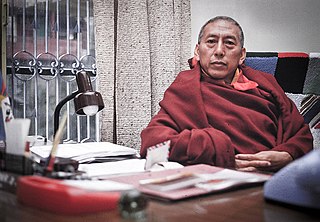
Lobsang Tenzin, better known by the titles Professor Venerable Samdhong Rinpoche and to Tibetans as the 5th Samdhong Rinpoche, is a Tibetan Buddhist monk and politician who served as the Prime Minister of the cabinet of the Central Tibetan Administration, the Tibetan government-in-exile based in Dharamshala, India.

The 11th Panchen Lama controversy centers on the 29 year-long enforced disappearance of Gedhun Choekyi Nyima, and on the recognition of the 11th Panchen Lama. The Panchen Lama is considered the second most important spiritual leader in Tibetan Buddhism after the Dalai Lama. Following the death of the 10th Panchen Lama, the 14th Dalai Lama recognized Gedhun Choekyi Nyima in 1995. Three days later, the People's Republic of China (PRC) abducted the Panchen Lama and his family. Months later, the PRC chose Gyaincain Norbu as its proxy Panchen Lama. During the traditional search process led by Chadrel Rinpoche, he indicated to the Dalai Lama that all signs pointed to Gedhun Choekyi Nyima, while the Dalai Lamas and Panchen Lamas recognize each other's incarnations. The PRC had established its own search committee, which included Chadrel Rinpoche and other monks, and wanted to use a lottery system referred to as the Golden Urn. Neither Gedhun Choekyi Nyima nor his family have been seen since the abduction. Chadrel Rinpoche was also arrested by Chinese authorities the day of the abduction, as were other people.

Tempa Tsering.
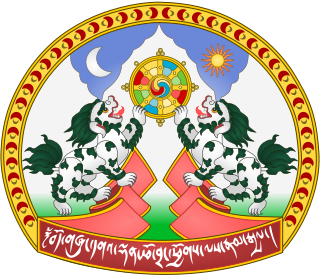
The Sikyong is the political leader of the Central Tibetan Administration, a Tibetan exile organisation in India also known as the Tibetan Government-in-Exile based on the 2011 Charter of Tibetans-in-exile. The title was created in 2012 after the 14th Dalai Lama decided not to assume any political and administrative authority as the head of the Tibetan Administration for Tibetans-in-exile.

The Tibetan Parliament in Exile (TPiE), officially the Parliament of the Central Tibetan Administration, is the unicameral and highest legislative organ of the Central Tibetan Administration, the government-in-exile of the Tibet Autonomous Region of China. It was established and is based in Dharamshala, India. The creation of this democratically elected body has been one of the major changes that the 14th Dalai Lama brought about in his efforts to introduce a democratic system of administration.

The Kashag was the governing council of Tibet during the rule of the Qing dynasty and post-Qing period until the 1950s. It was created in 1721, and set by Qianlong Emperor in 1751 for the Ganden Phodrang in the 13-Article Ordinance for the More Effective Governing of Tibet. In that year the Tibetan government was reorganized after the riots in Lhasa of the previous year. The civil administration was represented by the Council (Kashag) after the post of Desi was abolished by the Qing imperial court. The Qing imperial court wanted the 7th Dalai Lama to hold both religious and administrative rule, while strengthening the position of the High Commissioners.
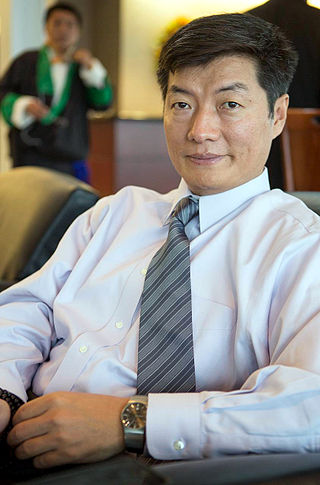
Lobsang Sangay is a Tibetan-American politician in exile who was Kalon Tripa of the Tibetan Administration in India from 2011 to 2012, and Sikyong of the Central Tibetan Administration in India from 2012 to 2021.
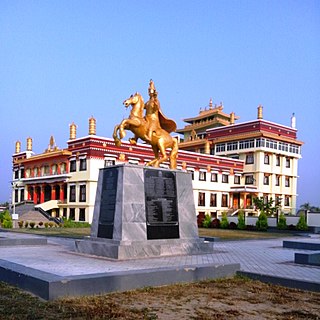
The Tibetan diaspora is the relocation of Tibetan people from Tibet, their country of origin, to other nation states to live as exiles and refugees in communities. The diaspora of Tibetan people began in the early 1950s, peaked after the 1959 Tibetan uprising, and continues.

The National Democratic Party of Tibet is a major party in the Tibetan government in exile, officially the Central Tibetan Administration, based in India.

Protests and uprisings in Tibet against the government of the People's Republic of China have occurred since 1950, and include the 1959 uprising, the 2008 uprising, and the subsequent self-immolation protests.

Alak Jigme Thinley Lhundup or Alak Jigme Lhundup Rinpoche was a Tibetan Tulku, as well as the former speaker of the Tibetan Parliament in Exile and former Minister with the exile Tibet administration.
Elections for the office of Sikyong and the Chitue (Members) of the Tibetan Parliament in Exile were held between October 18, 2015 and March 20, 2016. Tibetans in exile voted for the fourth time their political representative and executive of the Central Tibetan Administration, the self-proclaimed Tibetan government in exile. The election was overseen and organized by the independent CTA agency, Tibetan Election Commission.

Lobsang Nyandak, sometimes written Lobsang Nyendak also called Lobsang Nyandak Zayul is a Tibetan diplomat and politician. born in 1965 in Kalimpong, India where he performed his studies in Herbertpur and at Panjab University in Chandigarh. There, he held functions at Tibetan Youth Congress before becoming the founding Executive Director of the Tibetan Centre for Human Rights and Democracy. Member of the National Democratic Party of Tibet, he was elected deputy and was selected as a minister by Samdhong Rinpoche, the first elected Kalon Tripa of Central Tibetan Administration (CTA). He then was the Representative of the 14th Dalai Lama to the Americas and became president of The Tibet Fund.
The Tibet Policy Institute (TPI), founded in 2012, is a Tibetan think tank and research-oriented intellectual institute of the Central Tibetan Administration. TPI is based in Dharamshala, Himachal Pradesh, India.
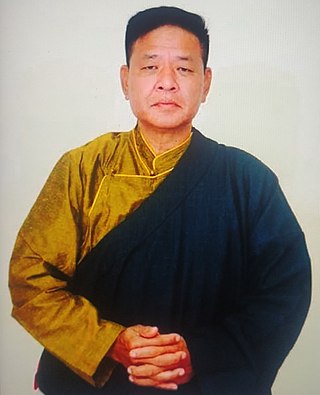
The Central Tibetan Administration, a government-in-exile of Tibet based in India, held an election for its next leader, the Sikyong, in 2021. Candidate Penpa Tsering won the election and succeeded Dr. Lobsang Sangay, who has served for two consecutive terms as Sikyong.

Kelsang Dorjee "Kaydor" Aukatsang is a Tibetan politician and candidate for the Central Tibetan Administration office of Sikyong. Kaydor was a close aide of the previous Sikyong, Dr. Lobsang Sangay, under whom he held various official positions including, the role of North America representative for the Dalai Lama, Chief Resilience Officer of the Central Tibetan Administration and the Director of the Social and Resource Development Fund (SARD).


















